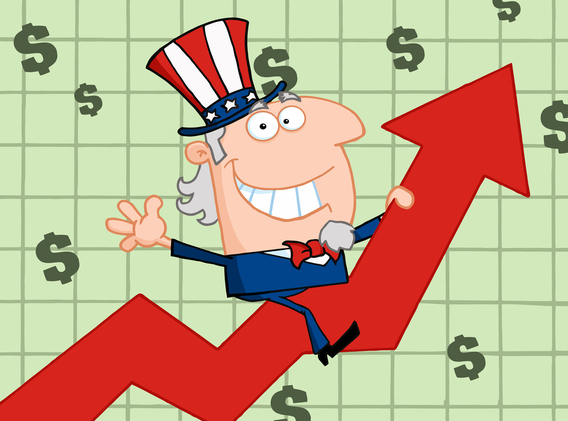I am not a gold bug, not by any measure, but the yellow stuff is starting to look very attractive here. Particularly, when you take into consideration the fact that the US Economy and it’s financial markets will go through a severe recession where the FED will be forced, once again, to flood the market with cheap credit. Is gold in a simple technical bounce or is it signalling the trouble ahead?
That is inconsequential for our purposes. What is important here is that the gold is reversing it’s technical downtrend. In all categories. Miners, ETFs and the metal itself. While the short term trend is already pointing up, if the gold is able to break above $1,400 over the next few months it will give us a clear indication that the trend has reversed. So, while the Goldman Sachs is telling you to “Sell”, I am telling you to put it on your watch list. The upside here can be significant.

Did you enjoy this article? If so, please share our blog with your friends as we try to get traction. Gratitude!!!

Click here to subscribe to my mailing list
Goldman Sachs Says “Sell Gold”. Is It Time To Load Up? Google
Gold Most Bullish Since 2012 as Goldman Sees Slump
Gold is getting more attractive to hedge-fund managers even as Goldman Sachs Group Inc. says the metal’s surprising rally this year will soon fizzle.
Hedge funds and other speculators expanded bets on higher prices for a fourth week in New York futures and are now the most bullish since December 2012, government data show. While gold is off to its best start in six years after topping $1,350 an ounce, Goldman’s Jeffrey Currie says chances are increasing that prices will slump to $1,000 for the first time since 2009.
This year’s 12 percent rally came amid signs of weakening U.S. economic growth and Russia’s incursion into Ukraine. Investors who shunned the metal in 2013 are once more buying the biggest exchange-traded product backed by gold, with holdings poised for the first quarterly gain in a year. Hedge funds also are adding to bullish wagers on sugar, corn and coffee, driving combined wagers on a commodity rally to a record.
“The gains have been impressive,” said Chad Morganlander, a fund manager with Stifel Nicolaus & Co Inc. in New Jersey, which oversees about $150 billion of assets. “There’s been a perfect storm of geopolitical uncertainty as well as growth scares here in the U.S.”
Weekly Gains
Gold futures in New York climbed 1.3 percent last week, the eighth advance this year. The Standard & Poor’s GSCI Spot Index of 24 raw materials rose 0.6 percent, while the MSCI All-Country World index of equities increased 0.3 percent. The Bloomberg Dollar Index, a gauge against 10 major trading partners, slipped less than 0.1 percent and the Bloomberg Treasury Bond Index dropped 0.7 percent.
The net-long position in gold climbed 3.8 percent to 118,241 futures and options in the week ended March 4, U.S. Commodity Futures Trading Commission data show. Short holdings declined 15 percent to 26,321, the lowest since October. Net-bullish holdings across 18 U.S.-traded commodities rose 9.7 percent to 1.59 million contracts, the most since the data begins in June 2006.
U.S. service industries, which range from health care to finance and make up almost 90 percent of the economy, grew last month at the slowest pace in four years, data from the Institute for Supply Management showed March 5. Holdings through gold ETPs rose in February for the first time since 2012. Assets in the SPDR (GLD) Gold Trust, the biggest such fund, are up 0.9 percent in 2014 after a 41 percent plunge last year that wiped $41.8 billion in value.
Billionaire Paulson
Billionaire hedge-fund manager John Paulson, who holds the biggest stake in SPDR, posted gains in his firm’s main strategies in February partly as bets on gold paid off.
Russia said it may cut off Ukraine’s gas supplies, and the U.S. has threatened more sanctions after authorizing financial restrictions last week. The escalating tension also drove up prices for energy and grains amid concern that supplies would be disrupted.
The turmoil in Ukraine doesn’t change Goldman’s bearish view on gold, and the recent weakness in the U.S. economy is probably weather driven, not “real deterioration,” said Currie, the bank’s head of commodities research. Lower mining costs mean it’s more probable than it was six months ago that prices will drop below $1,000, he said in an interview.
February Payrolls
American employers added more workers than projected in February, indicating the U.S. economy is starting to shake off the effects of the severe winter weather, government data showed March 7. The China Gold Association says demand in the nation is poised to drop to 250 metric tons this quarter, down 17 percent from a year earlier.
“Some kind of middle-ground solution in Ukraine is probably the case at some point,” said Rob Haworth, a Seattle-based senior investment strategist at U.S. Bank Wealth Management, which oversees $115 billion. “For the two big commodities, oil and gold, we’ve probably seen relative highs for the next month. Once this geopolitical risk premium ebbs, I don’t see a lot of fundamental speculative support to push gold a lot higher.”
Bullish bets on crude oil rose 2.2 percent to 346,469 contracts as of March 4, the most ever in records going back to June 2006, government data show. West Texas Intermediate reached $105.22 a barrel in New York March 3, the highest since September. Russia is the biggest energy exporter.
Frigid Weather
Frigid weather in the U.S. boosted demand for heating fuel, while supplies of natural gas and coal will decline to six-year lows by the end of this month, government data show.
Speculators switched from a net-long position in copper to a net-short holding of 2,567 contracts. On March 7, futures tumbled 4.2 percent in New York, the biggest drop since December 2011. China’s first onshore bond-market default raised concern that demand will ebb in the top metals consumer.
While Goldman and Citigroup Inc. expected raw materials to drop this year, extreme weather drove rallies in everything from coffee to soybeans. Seventeen of the 24 commodities in the GSCI index climbed in 2014, and eight of them have posted gains of 10 percent or more.
A measure of speculative positions across 11 agricultural products rose 22 percent to 855,764 contracts, the CFTC data show. That’s the highest since September 2012.
Speculators almost tripled their net-long position in sugar to 64,740, the highest since December. Futures climbed for six straight weeks, the longest rally since 2011, amid drought in Brazil, the biggest grower and exporter.
Brazil Drought
The prolonged dry spell and excessive heat have also erased prospects for a record coffee crop in Brazil, the top producer. Prices for arabica beans, the variety favored by Seattle-based Starbucks Corp. (SBUX), surged 81 percent since December. Investors increased their net-long position to the highest since May 2011.
Bullish bets on corn swelled 81 percent to 158,122 contracts, the most in almost a year. Futures reached a six-month high in Chicago last week. On average, U.S. export sales in the past four weeks have gained fivefold from a year earlier. Urkaine’s escalating turmoil is signaling that grain buyers may be forced to purchase more American supplies, according to the U.S. Grains Council.
Investors’ hog holdings rose 6.3 percent to 69,642 contracts, the highest since November. Futures surged 32 percent this year, reaching a record March 5. A deadly hog virus continues to spread through the U.S., killing piglets and limiting the outlook for pork supplies.
“You had factors influencing commodities that weren’t expected, the weather with the energies and the grains, and then geopolitical risk with the gold and the grains,” Donald Selkin, who helps manage about $3 billion as chief market strategist at National Securities Corp. in New York, said in a telephone interview. “Weather has been so crazy this year. The question is, can prices keep going up?”












